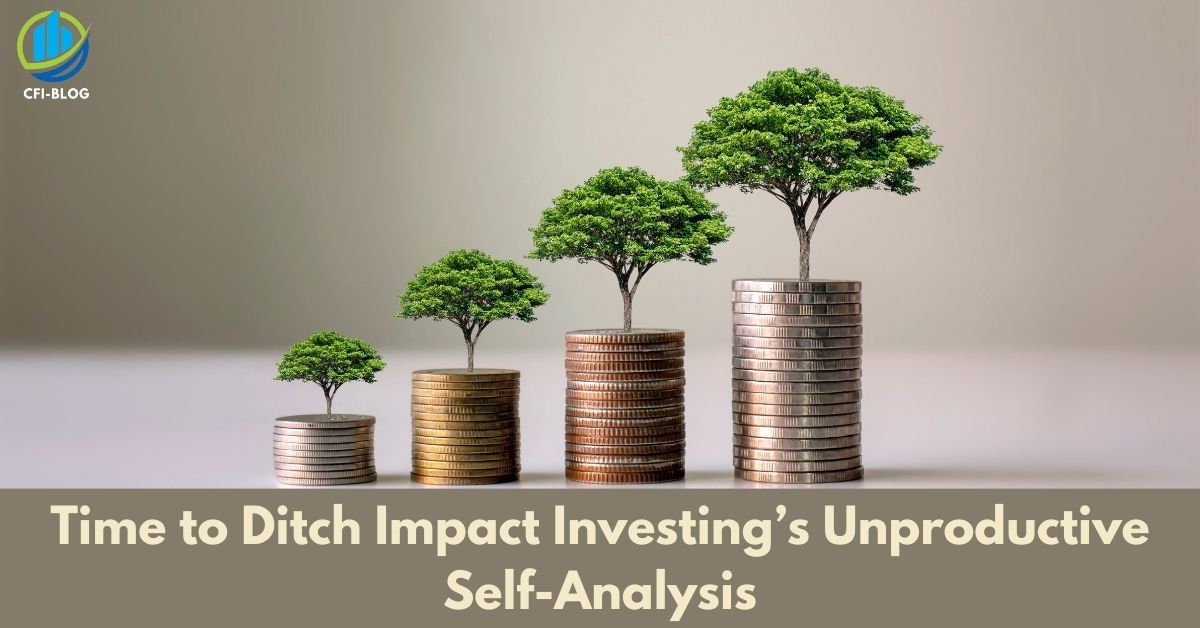Microfinancing was initially started with the intention to help lower-income individuals. The aim was not only to help them by providing financial capital but also to educate them about how to handle credit. The model was that they would give away affordable loans for the poor population, emerging businesses, and women entrepreneurs. With time, the model shifted to a profit-making one. It turned the organization into an industry where the motive was to push loans so that the wealthy people behind the organization could earn money.
Now Impact-based investment wants to avoid all the mistakes that microfinancing has done in the past. The challenge is huge as the company should maintain a balance between the companies and the stakeholder involved. It should not focus on financial return but rather concentrate on social betterment. Let’s see in this write-up how microfinancing failed and will impact based investment positively impact society.
What is Impact Investment?
Impact Investments are made by potential investors, for the betterment of society. Investors invest money into MFOs for providing affordable loans for the poor. The only difference between MFOs and impact investments is that impact investments look for returns for their investments while yielding social and environmental benefits to society. Investor can invest their money in developed countries, emerging markets, etc. for earning profit depending on where they can gain profit alongside resulting in benefits to the society out of the investments they make.

The impact investments target issues like sustainable agriculture, renewable energy conservation, etc. They target issues that will make an impact on the overall population of an area. The impact investments also look at issues such as health care, housing, and education in consideration. It provides affordable loans for essential things for our life and the MFOs (Micro Financial Organizations) present over there.
And, investors, when they invest in a company with intention of making impact investments, do not get involved with the company beforehand, they first look at the company’s duty towards society. This can be followed by CSR (Corporate Social Responsibility). Of course, every industry has a different angle towards social duties, even the investor knows different companies will follow different paths with impact investments.
Further, the companies that use impact investments, and develop sustainable energy, help poor people by providing them with education and employment. Sustainable practices will help the future of this world. Most of the impact investments are made by Institutional investors who invest in bulk for the betterment of society. Some of the impact investors also include banks, private foundations, pension funds, and various types of fund managers.
However, there are also other entities that provide impact investment such as some financial service providers who make some charity decisions. There are even some investor networks and web-based investments that offer investments in some companies that look forward to impacting investment.
Then, there are Micro financial loans, which are offered by MFOs for small-scale business that has just been set up, they even target women entrepreneurs for uplifting them by setting up their business. By applying behavioral insights inside Latin American financial institutions they have humanized the institution so that it can focus better on society. Micro financial organizations not only provide funds for help, they even provide business insights that are needed in making informed financial decisions.
Types of Impact Investment
There are many types of impact investment, based on industries and return type they are categorized. Just like in the case of other investments, in impact investments, investors have a varied number of choices based on the return type they invest the money. Some of the impact investors have a vision and a category that they want to target. They invest money in that type of industry only.
Impact investment targets different types of industries. Investors can decide whether to put their money in an emerging market or a developed one based on their return strategy. The industry type includes:
- Healthcare
- Education
- Energy, especially clean and renewable energy
- Agriculture
Environmental, social, and governance (ESG)
ESG is a type of impact investment. In this type of practice, the financial aspect of the investment is kept a top priority. In this type the investor avoids technical valuations, he focuses on the factors that enhance some of the traditional financial analysis by listing out risks that could happen and opportunities that can be achieved. While investing the impact investor might think about social betterment in his conscious, but the main motive will be the financial performance of the loan.
Socially responsible investing (SRI)
In the case of SRI type of investments, the investor looks beyond the ESG type of investment. In this type of investment, the investor targets some type of ethical regulations. The main motive behind this type of investment is for the betterment of some kind of particular religion, race, or community. In the case of ESG investments categorical investment was not the case, in their financial outcome was the main motive. However, in the case of SRI type of investments, they use the factors of ESG investment in selecting the right way to invest money. The difference being SRI investments focus on one type of community and ESG investments do not have a particular type.
Special Considerations

In special consideration comes investments are done for social and environmental betterment. The companies have not understood that investing in a sustainable environment is better for their company, as most people nowadays are attracted to companies that think about the future, that invest in the betterment of society as in whole. Especially today’s youth follow companies that have taken these types of initiatives, people feel responsible towards our mother earth and want to give back, in whatever way possible. So investors look at this as an investment opportunity as if they do impact investments lot of people will follow them resulting in an expansion of market size.
Impact investing results in profit according to some reports. There was a survey conducted by the Global Impact Investing Network in the year 2020, the survey found that over 88% of the impact investments made by investors had profits. The investors had profits even more than they had projected before.
With impact investments, the investors want the companies that are still not into social welfare to know that, by impact investing the companies can make profits and make a great image among local people. In the U.S. expanding financial inclusion and negating the repeal of the affordable care act would mean financial inclusion in the US. This would help communities staying over there get financial access. The investors do not completely control the companies, they support decisions taken by the company in terms of social welfare. The investors have a responsibility toward companies welfare.
Impact Investing vs. Socially Responsible Investing (SRI)
There is a big difference between Impact investing and Social Investing. In the case of impact investing, the investor looks for financial gain for his investment. The investments are done without following any type of guidelines. The investor follows return strategies to invest his money to get better investments. Well, in the case of SRI investment financial returns are not the topmost priority. SRI investments aim for social and environmental upliftment. Impact investments also aim for social betterment but financial returns are the main motive behind their investments.
SRI investments are also called green investing. In this type of investment, a particular type of community is selected, and then the investments are targeted to that kind of community. In the case of SRI investments investors choose companies that follow their mindset and thought process toward the betterment of society. Where else in the case of impact investing, the investor finds companies that help society and leaves the company to its job without any kind of interruptions.
Difference between Microfinance and Impact Investing
There are major conflicts on the use of microfinancing and impact investments.
Well, microfinance helps people but if it helps people then how much does it help? According to some people, microfinance caters to the poor population of this world, it is one type of basic human right for the people. Then there are some people who consider microfinancing only makes the wealthy richer, it has nothing to do with the betterment of the poor population. A complete study also couldn’t find which version of the story is true. However, it doesn’t make microfinancing the best possible way to serve the poor—not the perfect method to serve them.
However, the question arises whether should microfinancing earn money. If yes, then how much money should they earn? Even in this debate, there are two schools’ thoughts, some people agree that microfinance organizations should earn profit just like commercial institutions. They believe that for microfinancing to scale up and spread to many people it needed to earn profit and focus a bit on commercial gain.
And, there were some other types of people who believed that micro-financial institutions are there to serve social concerns which is why they do not need to focus on the financial aspect of the organization. They think that people who are investing in microfinance organizations are already wealthy people they don’t need any more profit to help the underserved.
As mentioned in many studies, microfinance institutions focussed primarily on giving away loans, they didn’t bring up savings account facilities, and they didn’t propagate to the people that saving is a form of earning. It provides interest rates which allow you to earn money on your savings.

In some microfinance institutions savings account was not allowed to open if that person didn’t take a loan. People had to take up loans if they wanted benefits from microfinancing. This used to happen because in loans the profit margin was higher as compared to a savings account, which is why microfinance institutions pushed loans over a savings account. This just shows how microfinancing institutions focus on profits rather than serving the poor population.
Without thinking about the aspect of helping the poor, the industry thought about scaling the microfinancing organization. They just wanted to increase the reach of microfinance to everyone, without even thinking, does it actually help the poor? Even if the organization would work for the underserved, under what circumstances the organization would best work without prioritizing the profits? This issue was also not dealt with, before scaling up microfinancing organizations.
When microfinancing was initially started, the founders wanted to make it a profitable organization to attract as many as investors possible, resulting in a huge portfolio of investors. But, the question arises, are commercial banks ready to serve the base of the pyramid? This question started the initiation of microfinance Institutions, as banks didn’t focus on the local people. By the year 2010, the founders even succeeded in making this happen. A microfinance institution based in Mexico which was majorly owned by Accion International was able to take public offerings.
At the moment in time, the organization’s worth was $1.5 billion, so this would mean the shareholders got 250x in return for their initial investment of $6 million. If we calculate the returns received every year it would turn out to be a 100% annual return which was compounded for eight years. this turned out to be one of the highest-grossing IPOs in a year, this happened in a year when the market was in a depression due to mortgage lending issues.
In the year 2010, India also witnessed the same thing, there was a microfinance institution called SKS, that went through an IPO and received millions in investments. The deal had its share fair share of scandal and complications. However, in both cases, the large number of shares that were bought through an IPO were owned by nonprofit organizations, which aimed at spending this money for the betterment of society.
Consequently, the total investment globally came out to be somewhere around $38 billion. And the number of beneficiaries was around $624 million. Microfinancing really turned out to be a huge industry. The industry was scaling at a rapid pace, and generating huge profits. Due to this for some people, it was confusing as the organization’s main aim was to look after the betterment of the poor rather than earning profit. There was a study conducted by Mark M. Pitt and Shahidur R.Khandker that told the impact microfinancing had on eradicating poverty.
However, this report was thrown out by famous scientist David Roodman, who stated that the report was based on false methodology. Then, Grameen Banks, founder Mr. Muhammad Yunus who had initially started the microfinance made a complete report in 2010, stating that there has been no impact on poverty by the micro financial institutes, the benefits have been only to the established business who had taken loans from the microfinance.
In short, there was no positive impact on poverty, which was initially aimed at microfinancing institutions. This just shows how microfinancing institutions, had a big flaw in how they used to function this is where impact-based investments had to change.
Well, at the initial start of the impact-based investment, the main challenge was to follow the same mistakes made by micro-financial institutes. There should be a perfect balance between financial return and the impact an institution can bring. For these to happen impact-based investments had to follow three principles laid down by the Non-profit transform Finance. The first one is the engagement of the communities in the overall design, functionality, and overall process of the organization. Secondly, the people running the organization should focus on the impact rather than the financial aspect of the organization. lastly, the organization should find the right balance between the investors and the stakeholders and deliver, so that everyone is benefited in the end.
However, following these rules might not allow impact-based investment sales at a rapid pace. Although it is necessary for them to understand these rules and follow them as the goal it helps the poor not earn profit. To make this possible at the beginning the companies need to have connections with the communities that the company will be serving, and build infrastructure around them to make them feel connected to the whole process. They should also look at financial inclusion by tackling five challenges to accelerate financial inclusion in that particular area. All these will be possible if everyone involved works together for a single goal. The goal must be to give help and education to the underserved, it should not be to earn profit and make the wealthy richer.
Keeping the right balance between, financial return and impact can seem difficult, but it is necessary for the existence of the company. The only way to execute this is to focus on the impact part rather than the return part.
Impact Investment: Profit vs. Impact on Communities
Now, if we see the growth of impact investments, it has had a tremendous journey so far. J.P. Morgan in the year 2010, even projected the amount of money that would be invested; the amount was around $1 trillion. This amount is twice the amount of many developing countries’ GDP as per the United Nations. Some of the start-ups in India have received Forbes India awards FINO – Startup of the Year as they made a 1 billion dollar company, some of the other impact investors have also won this award. Many people just hope that the investment should help the poor and not just provide returns to the investor. The amount should help society and preserve the environment for future generations.
However, there is still doubt as to whether the impact-based investment model will fail just like the microfinance model. Will the money actually reach the poor as a helping aid or not? As far as profitability goes, impact-based investments are achieving profit. So it makes them sustainable for the future. As it is a profitable large number of investors may join it and provide help to a large scale of people.
However, again the worry starts to build as with an increase in profit, the social impact often gets hampered. That is why we should scale impact-based investment only if the impact is maximized, otherwise, the industry will grow to leave the poor population just as they were before. There should be regular checks as to how much the industry is growing and how much of an impact it is causing. Impact-based investment should learn from the mistakes of microfinancing. Microfinancing was also started with the aim of helping the poor population, but it then got diverted; it focussed on profits rather than overall impact.
But, impact-based investment has actual data on microfinancing as to what went wrong; they can learn from them and avoid those mistakes that were committed by micro financing. If done properly, then the Industry, which was initially formed to help the underserved, will actually help the underserved.
Conclusion
As we have seen in this article, microfinancing was initially started as a way to help the poor. They started out by providing affordable loans to the underserved. They used to provide even financial education to allow low-income individuals to make informed financial decisions. However, micro-financial institutes diverted from social impact to the profit-making industry. They used to push loans more than a savings account, as loans had a higher profit margin than others.
This is where there was a gap in institutions helping the undeserved. Then came impact-based investments; these investments were made by some financial institutes or banks, etc. The investors would invest money in companies that aimed for social betterment. In some cases, they aimed for a particular community, whereas some companies helped society as in whole. The investors even got returns on their investment, but the return was not their primary aim.
Still, impact-based investments have to learn from the mistakes made by microfinancing and not follow in their footsteps. They should make the community lot more involved in the whole process, and they should find the right balance between stakeholders and investors. By following these steps, impact-based investments can really make an impact on society.
Frequently Asked Questions (FAQs)
Q1. What are the 3 key elements of impact investing?
There are 3 key elements that impact-based investing follows to maintain its existence.
- Intentionality
There should be a solid intention of the investor to help a certain community, this lays the foundation for impact-based investments. This reason separates this from the rest of the investments.
- Manage Impact Performance
There should be a value to what extent the impact has been reached. This allows any organization to keep a balance between financial return and overall impact on society.
- The use of evidence to make investment design
There needs to be a strategy before investing; it can’t be based on hunches. For making a proper strategy, evidence of previous investments should be taken into account; this will allow the company to make a new effective design for investment.
Q2. How do you measure the impact of impact investing?
There are certain parameters that can allow a company to measure the impact of an investment.
- Assess the Relevance and Scale
- Identify Target Social or Environmental Outcomes
- Estimate the Economic Value of Those Outcomes to Society
- Adjust for Risks
- Estimate Terminal Value
- Calculate Social Return on Every Dollar Spent
Q3. What are the stages of impact investing?
To initiate impact-based investing, there are certain steps that need to be followed. The three steps include
- Prepare
- Build
- Refine
Author Profile

- Jonas Taylor is a financial expert and experienced writer with a focus on finance news, accounting software, and related topics. He has a talent for explaining complex financial concepts in an accessible way and has published high-quality content in various publications. He is dedicated to delivering valuable information to readers, staying up-to-date with financial news and trends, and sharing his expertise with others.
Latest entries
 BlogOctober 30, 2023Exposing the Money Myth: Financing Real Estate Deals
BlogOctober 30, 2023Exposing the Money Myth: Financing Real Estate Deals BlogOctober 30, 2023Real Estate Success: Motivation
BlogOctober 30, 2023Real Estate Success: Motivation BlogOctober 28, 2023The Santa Claus Rally
BlogOctober 28, 2023The Santa Claus Rally BlogOctober 28, 2023Build Your Team – the Importance of Networking for Traders
BlogOctober 28, 2023Build Your Team – the Importance of Networking for Traders

